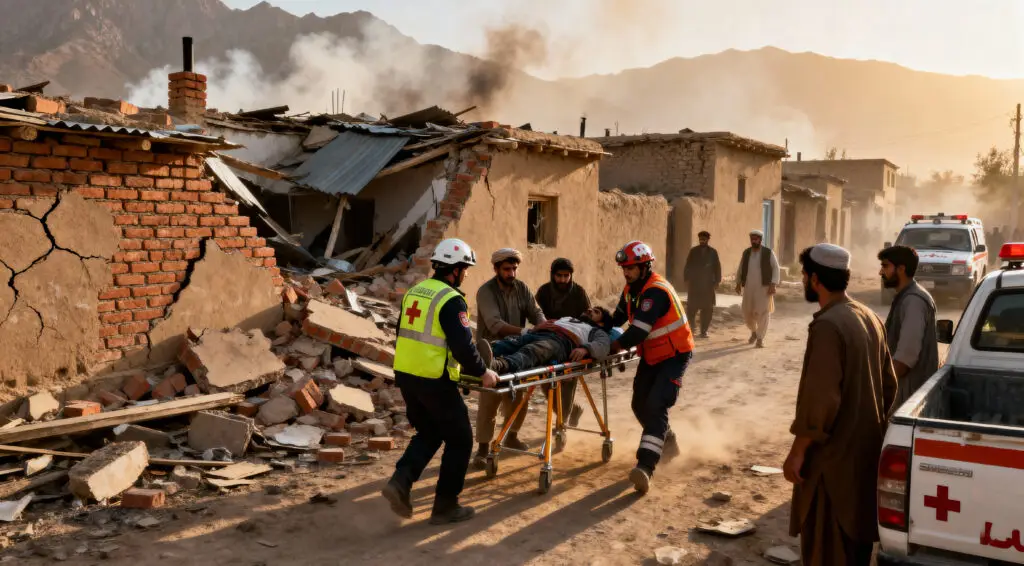6.3-Magnitude Earthquake Kills Nine and Injures Over 120 in Afghanistan
A strong earthquake struck northern Afghanistan overnight, killing at least nine people and injuring more than 120 others, according to local authorities and the National Disaster Management Authority (NDMA). The tremor adds to a series of devastating natural disasters that have battered the country in recent years.
The U.S. Geological Survey reported that the 6.3-magnitude quake occurred at a shallow depth of 28 kilometers (17 miles), with its epicenter located near the city of Mazar-i-Sharif in Balkh province. The region, home to more than half a million residents, experienced widespread shaking that sent people rushing into the streets.
Northern Provinces Suffer Heavy Damage as Hospitals Mobilize
Officials in Balkh province confirmed that four people were killed and over 120 were hospitalized after the quake damaged dozens of homes and public buildings. “Many victims sustained injuries from falling debris,” said Kamal Khan Zadran, a spokesperson for the provincial health department. “Emergency teams are working through the day to assist affected families.”
Neighboring Samangan province also reported casualties. NDMA spokesman Mohammadullah Hamad said five people were confirmed dead and 143 others were injured. “Most of the wounded have now been discharged after receiving initial treatment,” he added.
Rescue Operations Hindered by Poor Infrastructure
Afghanistan’s mountainous terrain and limited communication networks have hampered rescue efforts. Many rural areas remain inaccessible hours after the tremor due to damaged roads and unstable slopes. Emergency responders continue to assess the extent of destruction in remote villages, where reports of collapsed homes are still emerging.
Witnesses in Mazar-i-Sharif described scenes of panic as buildings shook violently. “People ran into open spaces, afraid their houses would fall,” said local resident Rahimullah Khan. “The ground moved like a wave.” Tremors were also felt in Kabul, about 420 kilometers to the south, according to the Afghanistan Seismological Authority.
Recommended Article: Louisiana Residents Get Repair Aid After Hurricane Francine
A Nation Struggling With Consecutive Natural Disasters
The latest earthquake comes just months after another deadly quake in eastern Afghanistan that killed more than 2,200 people. The country has faced three major tremors since the Taliban regained control in 2021, underscoring the fragile state of its infrastructure and emergency preparedness.
Past earthquakes in Herat (2023) and Nangarhar (2022) killed hundreds and destroyed thousands of homes, compounding Afghanistan’s ongoing humanitarian crisis. The United Nations has warned that disaster recovery efforts remain slow due to international sanctions, drought, and reduced foreign aid.
Growing Humanitarian Concerns and Economic Strain
Aid organizations report that the new disaster will further strain relief operations. “We are deeply concerned about the cumulative impact on already vulnerable communities,” said UN humanitarian coordinator Aisha Mahmoud. “Access to clean water, food, and shelter remains a major challenge across quake-hit regions.”
The Afghan economy continues to struggle under financial restrictions, a fragile banking sector, and limited international assistance. Millions of citizens face hunger and displacement, while many returning migrants from Iran and Pakistan add further pressure to local resources.
Earthquake-Prone Geography Poses Ongoing Risk
Afghanistan’s position along the Hindu Kush mountain range — where the Eurasian and Indian tectonic plates meet — makes it one of the most seismically active regions in Asia. Many homes, especially in rural areas, are poorly constructed and unable to withstand even moderate tremors.
Experts emphasize the urgent need for investment in earthquake-resistant infrastructure and community preparedness programs. “The country must integrate disaster resilience into its rebuilding efforts,” said geologist Dr. Haroon Safi of Kabul University. “Each quake is a reminder that Afghanistan cannot afford to remain unprepared.”
About the National Disaster Management Authority (NDMA)
The National Disaster Management Authority (NDMA) of Afghanistan leads coordination of disaster risk reduction, emergency response, and recovery operations nationwide. NDMA partners with local authorities, international agencies, and NGOs to enhance community resilience and provide rapid humanitarian assistance.























